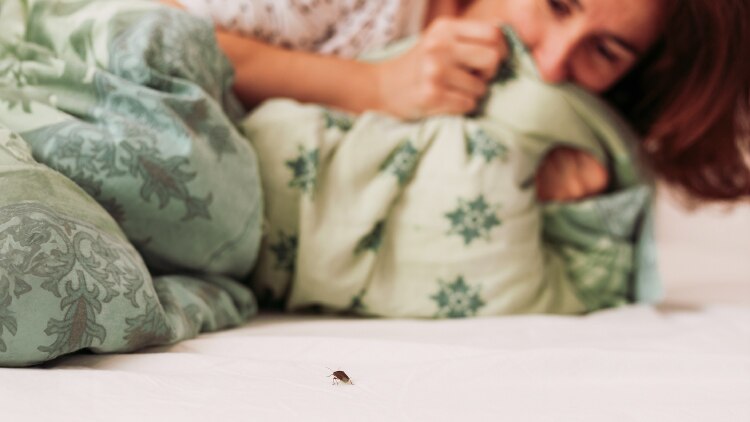

【Bed Bug Infestation】Bed Bug Causes and Solutions
Bed bugs are annoying pests that feed on the blood of humans and animals, primarily active at night. Although bed bugs do not transmit diseases, their bites can cause skin irritation and even allergic reactions. Additionally, their presence can negatively impact quality of life, causing anxiety and distress. In this article, we will explore the causes of bed bug infestations, possible transmission routes, health effects, and effective prevention and treatment methods to help you stay free from these bothersome pests.
Bed Bugs Characteristics and
Life Cycle
Bed bugs (Cimex lectularius) are parasitic insects with small, flat bodies. Adult bed bugs are about 5-7 mm long. They are reddish-brown before feeding and turn swollen and dark red after a blood meal. They have no wings and cannot fly, but they can crawl quickly and hide in narrow spaces such as furniture, mattresses, and wall crevices.
Bed bugs are nocturnal, meaning they are active at night and hide during the day in places like bed frames, mattresses, wall cracks, carpets, and furniture joints. They feed exclusively on blood, usually for 3-10 minutes at a time before retreating to their hiding spots to digest. Bed bugs reproduce quickly that one female can lay hundreds of eggs in her lifetime. In warm and humid environments, their population can grow rapidly.
Causes of Bed Bug Infestations
Many people assume that bed bugs only appear in dirty environments, but in reality, their presence is not directly related to cleanliness. Even clean homes can experience bed bug infestations. Here are some common ways bed bugs spread:
1. Carrying Bed Bugs from Travel
Bed bugs often hide in hotel beds, sofas, and carpets. Travelers may unknowingly bring bed bugs or their eggs back home in luggage, clothing, or bags.
2. Second-Hand Furniture and Household Items
Purchasing or picking up second-hand furniture, mattresses, sofas, or carpets can introduce bed bugs into your home. These pests hide in furniture crevices and may not be visible to the naked eye.
3. Contact in Public Places
Bed bugs can be found in public transportation (such as subways, buses, and airplanes), cinemas, and libraries. Sitting on infested seats or cushions can transfer bed bugs to your clothes or belongings.
4. Neighbor-to-Neighbor Transmission
In apartments or shared housing, bed bugs can travel between rooms through wall cracks, pipes, and electrical wiring. If a neighbor has bed bugs, they may spread to adjacent units.
Health Risks of Bed Bugs
1. Skin Reactions
Bed bug bites cause red, itchy welts on the skin, often appearing as small red spots or raised rashes. Some people may have allergic reactions, leading to more severe swelling and inflammation.
2. Allergies and Infections
Scratching bed bug bites excessively can break the skin, increasing the risk of bacterial infections. Some people are allergic to bed bug secretions or feces, which can lead to respiratory issues or skin inflammation.
3. Sleep Disturbance and Psychological Stress
Bed bug bites can cause discomfort at night, affecting sleep quality. Over time, this can lead to anxiety or insomnia.
Bed Bugs Prevention
1. Travel Precautions
- Check the mattress, pillows, and bed frame for bed bugs or black fecal stains before staying in a hotel
- Avoid placing luggage on beds or carpets, use a luggage rack instead
2. Home Protection
- Regularly inspect mattresses, sofas, and furniture crevices for bed bugs
- Avoid picking up or buying second-hand furniture from unknown sources
3. Personal Hygiene Habits
- Wash clothes in hot water immediately after returning from a trip, clean luggage with a vacuum and store it in a sealed bag
- Change bed sheets regularly and dry them at high temperatures
Ways to Get Rid of Bed Bugs
Many people assume that store-bought insecticides can completely eliminate bed bugs, but these pests have developed resistance to some chemicals. Relying solely on insecticides may not be effective. Here are some recommended methods:
1. Vacuum Cleaning
Use a vacuum to clean mattresses, carpets, and corners. Place an insecticide inside the vacuum bag to prevent bed bugs from escaping.
2. High-Temperature Steam Treatment
Bed bugs are sensitive to heat. Using a steam cleaner at 80°C or higher can effectively kill bed bugs and their eggs.
3. Hot Water Washing and Drying
Wash infested bedding, clothing, and curtains in 60°C-80°C hot water and dry them at high temperatures.
4. Chemical Insecticides
Use specialized bed bug insecticides and spray them in hiding spots such as bed frames, wall crevices, and under carpets. Ensure proper ventilation when using chemicals and follow product instructions.
5. Professional Pest Control Services
For severe infestations, hiring a professional extermination service is recommended to ensure complete eradication.
Although bed bugs do not transmit diseases, they cause skin irritation, psychological stress, and sleep disturbances, making them a serious nuisance. Prevention and timely treatment are key. If you notice signs of bed bugs, take immediate action using methods such as high-temperature cleaning, vacuuming, and insecticides, or seek professional extermination services. By maintaining good hygiene and conducting regular inspections, you can effectively prevent bed bug infestations and enjoy a comfortable, pest-free home!

